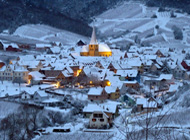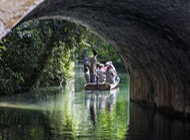 |
A stroll in the quaint one-street village of Niedermorschwihr takes you on a discovery path of architectural treasures : several wine growers' beautiful houses of Renaissance style, of the 18th century, half-timbered or made of stone as well as oriel windows. The Saint Gall's church dating back to the 18th century has a listed architectural rarity only fifteen times in Europe: the twisted bell tower of the 13th century Gothic bell-tower, with another rarity: a Silbermann organ of 1726. |
 |
Niedermorschwihr is home to Christine Ferber's boutique of world renowned jams and other delicacies. Chefs throughout the world have long prized the rare and delicious creations of Christine Ferber. Known as the "Queen of Confiture," Ferber prides herself in hand picking the freshest ingredients to go in each of her jams. One of the many things that make Christine Ferber's jams so special is that she will pick the best of the seasonal fruit. Enjoy a life changing bite of her Pumpkin Orange in the fall, the Confiture De Noel that is made up of dried fruits for the winter, a mouth-watering jar of White Cherry in the Spring, or even the best Strawberry jam you will ever taste year-round. There are dozens of amazing flavors, each unique in its own taste. |
 |
At the heart of the Alsace Wine Route, Colmar is very well located and while it may not be the capital of Alsace, it remains one of its top tourist destinations. The city has a rich architectural and cultural heritage that is impressive for its size (80,000 inhabitants in its metropolitan area). A stroll in the medieval Old Town is a real time warp with its very well preserved colourful half-timbered houses neatly lining the cobblestone streets and walkways. This is the perfect opportunity to admire Colmar's numerous architectural assets, among which the Maison Pfister, a beautiful bourgeois Renaissance house, the "Maison des Têtes" ("House of the heads"), the façade of which is adorned by 111 heads, a double "loggia" and a statue of Bartholdi. The Tanners District, bordered by the mills canal, is typical with its tall, straight half-timbered houses from the 17th and 18th centuries surmounted by attics that were used to dry the skins. Do not miss the Quai de la Poissonnerie (fisherman's warf) situated in the lovely Little Venice District and the Ancient Customs House (14th century) with magnificent stained glass windows and colourful rooftops. The Old Town also provides excellent opportunities to visit local restaurants and enjoy the local Alsatian cuisine.
|
 |
 |
A few buildings bear witness to the town's rich religious past, such as the Church of the Dominicans that shelters Martin Schongauer's major work : the beautiful "Madonna of the Rose Bush". Not to be missed is the gothic Saint Martin Collegiate Church built in pink sandstone from the Vosges. The Unterlinden Museum, housed in a 13th century Dominican convent has a well-established reputation, thanks to its most precious offering: Matthias Grünewald's "Issenheim Altarpiece" (Retable d'Issenheim). It is now France's most visited Museum of Fine Arts, after those of Paris. The museum displays collections of popular and decorative art from Alsace and the Upper Rhine, dating from the Middle Ages through to the Renaissance, as well as collections of archaeology, sacred art and modern art. You can also pay a visit to the Bartholdi Museum located in the hotel belonging to the family of the sculptor who had owned it since the Revolution. The famous sculptor, Auguste Bartholdi (1834-1904), was born in this building which was modified in the 18th century. He built, among other things, the monumental Belfort Lion and the Statue of Liberty in New York City.
|
 |
















